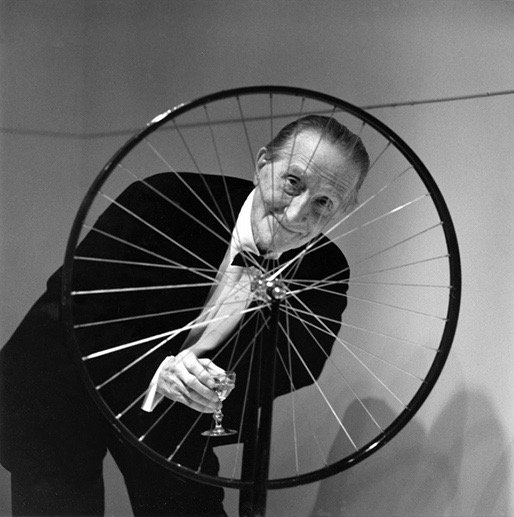Found Objects & Readymades
The “found object” (from the French objet trouvé) is an object of interest, a curio, discovered through happenstance. Anything can be a found object, although an element of strangeness, of otherness, is hoped for. A pretty pebble or shell, picked up on the beach, may be a found object in the literal sense. But an objet trouvé offers that added sense of wonder. “Regardez-moi,” it says, beckoning to you from the shelf.
Context is important. A “dolly block,” for example, is a small, hand-held anvil (like the apostrophe-shaped one pictured on the previous page), used to repair dents In an auto body shop. In the shop, it is unremarkable, something to be expected; however, that same object, taken out of its regular context, becomes mysterious and intriguing. It asks us to consider its merits aside from its intended, practical purpose. We may simply find it beautiful, because of its sculptural form. Or it may take on wholly new meanings.
A “readymade” is a found object with artistic aspirations. The concept was popularized by artist Marcel Duchamp, a co-founder of the DADA movement, especially during his New York period (1913-1921). He adapted the term from the garment industry term prêt-à-porter ('ready-to-wear'), and defined it as: "everyday objects raised to the dignity of a work of art by the artist's act of choice." So, the readymade acquires its status as “art” via the intention of the artist. It’s art because an artist put it there!
Perhaps Duchamp’s most famous readymade was his 1917 work “Fountain” (possibly conceived with the aid of an anonymous collaborator). “Fountain” was a porcelain urinal which the artist turned 90° from its intended orientation, and set on a pedestal. It scandalized the art world, just as Duchamp had intended. By selecting such an unloved object, the artist was promoting the DADA concept that bourgeoisie, “retinal” (pretty) art was obsolete. It was to be replaced by a conceptual art— an art of ideas.
As conceptual (or at least abstract) art achieved dominance later in the 20th century, “Fountain” was lauded not only for its cheek and its conceptual bona-fides, but also for its form. Observers saw a seated Buddha, a Madonna, a vagina, or whatever they wished. In 1961, Duchamp wrote (in a letter to fellow Dadaist Hans Richter) “When I discovered the ready-mades I sought to discourage aesthetics… I threw the bottle rack and the urinal into their faces as a challenge and now they admire them for their aesthetic beauty!” You just can’t win.
We are comfortable calling a particular found object a “readymade” if it satisfies certain criteria. First, the object should be more than just interesting, or aesthetically appealing. It should engage the viewer intellectually. The second is the matter of the artist’s intention. Does shifting an object from its original context to a new one reveal (or enhance) some deeper meaning? Is it just a cool object, or does it really make you think? That’s what Duchamp would want.
In a post-industrial age, objects that have fallen into disuse can easily become objects of mystery, re-contextualized simply by obsolescence. The dolly block mentioned earlier is a good example; most people will never see one in the course of their lives. Such objects carry mystery, and can be very powerful. Care must be taken, however, to avoid the trap of mere nostalgia. Every antique mall in North America has a section of “man-tiques” — old tools that recall simpler times. A hayfork or an ice-saw may be interesting objects, but do they inspire wonder? It’s for the beholder to decide.
Readymade, or “man-tique? You decide!
Some art historians feel the term “readymade” should refer only to works by Duchamp himself. However, the concept of generic, unloved objects being elevated to art by the finder certainly predates the DADA movement. Untutored (“outsider”) artists produce “readymades” to this day, without necessarily having any awareness of Duchamp and his circle. It’s a concept that will always be with us, so we think the term should be used more broadly.


